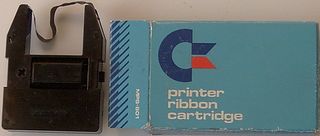MPS-1000
| MPS-1000 | |
 | |
| Type: | Dot-Matrix Printer |
| Producer: | Commodore |
| Price: | 299.95 ($712.33 in 2020) |
| Released: | 1985 |
| Discontinued: | 199? |
| Processor: | |
| Memory: | |
| OS: | |
| Info: | Follower: MPS-1200 |
The Commodore MPS-1000 is a dot matrix printer (stylus printer) from Commodore released in the year 1985. MPS stands for Matrix Printer System, an invention from Commodore.
Description[edit | edit source]
The Commodore MPS-1000 was one of the later printers offered by Commodore for its home computers, in order to provide more functionality and match the modern slimline designs of the Commodore 128 and Commodore 64C. It was a Commodore-branded and modified Epson LX-80 (or Epson Homewriter 10). The printer used fan-fold paper via a paper tractor, or friction single sheet feed. The print resolution was a 9x8 matrix at 10 characters per inch. The printing speed was about 100 chars per second in draft mode, 20 cps in NLQ mode.
Because of its 9-pin print head, the printer supported character descenders not acheivable on earlier printers. The printer also supports bi-directional printing, for faster printing. The printer supported both the serial IEEE-488 interface, as well as a parallel interface for the Amiga and other Centronics based computers ("IBM mode"). Through a series of dip switches in the back, these changes and character set changes could be made. In serial (Commodore) mode, it is compatible with nearly all Commodore 1525 printing routines.
The printer was not developed and produced by Commodore. The MPS-1000 was produced by the Japanese company Seiko Epson, or simply Epson, a subsidiary of the clock manufacturer Seiko. At that time, Seikosha was one of the largest printer manufacturers in the world and was also manufacturing printers for Atari, such as the Atari 1029 printer.
Apart from the complete ASCII-charset the 1000 could also print all Commodore graphic characters and reverse characters were possible, along with all IBM characters and extended characters. In addition to text and special glyphs the printer was capable of printing graphics.
For manual paper-handling there was a mechanical handwheel on the right side of the printer. Additionally buttons were provided for taking the printer on/offline, incremental linefeed, and form feed.
Technical Data[edit | edit source]

- Print method: Matrix print, friction feed
- Dot matrix: 9x8-Dots draft, 12x18 NLQ
- Character height: 3.1 mm
- Row length: Max. 80 Columns
- Print speed: 100 chars/sec.
- Print method: bi-directional print
- Paper transport: Tractor, manual feed
- Ink-ribbon type: 2-parts cassette with exchangeable ink reservoir
- Paper width: 4.5 to 8 inch
- Copies/carbon copies: Original + 2 carbon copies
- Graphics: Dot matrix, 8 vertical dots/column
- Dimensions: 420 mm × 330 mm × 80 mm
- Weight: Approx. 4.8 kg
- Price: Approx. 795,- DM (year 1984)